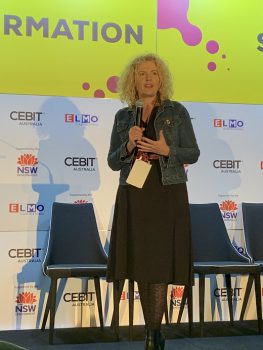Blockchain technology is useful in improving the quality of government data, however the immaturity of the technology can be a hindrance, an industry expert says.

At the CEBIT conference last Wednesday, Katrina Donaghy, co-founder and CEO of Civic Ledger, said that Australia has been slow in its uptake of the technology because of its immaturity.
“I think it’s because we do get caught in the immaturity of the technology, we’re waiting for someone to come along and say ‘here is your standard, here is your regulatory framework, here’s the law, so now go and play with this technology’,” she said at the conference.
Ms Donaghy suggests looking back to the launch of the internet, which also had a slow uptake initially.
“We’re very similar with blockchain technology, the highways are still getting built, we’re still trying to solve the problems around scalability and security and things like that, but the only way that we can actually get better at this is actually playing with it,” she said.
Blockchain technology provides a public ledger of information collected via a network. While it allows for digital information to be distributed, each piece of data has only one owner, which means it can’t be copied, making it useful for payments and marketplaces, Ms Donaghy says.
“The only way that we can actually get better at this is actually playing with it.
Four roles for governments to play
Blockchain is probably “the last place that you would imagine that the government would be looking at or working with”, Ms Donaghy says, but it has many benefits for them to “bring transparency, security and immutability” to their data, and there are four roles they can play.
“They are a convenor, whereby they are there to lead and provide a strategic oversight or strategic policy; they are also a financier, whereby they provide us mechanisms for financing R&D for innovation to occur,” she said.
“But they are also there to co-create and also use this technology, but the last thing is about regulator; governments are there to also regulate this technology.”
For governments wanting to use this technology, Ms Donaghy said they need to acknowledge that it would be a business decision as well as a technological decision.
Before building the technology team, they need to identify and agree on the problem that needs to be solved.
“Often you get problem statements, and then you start unpacking it and you realise that you’re actually solving the problem for the wrong reason, for the wrong person or the wrong customer,” she said.
An important aspect of blockchain technology is asking where the incentives are in a transaction, Ms Donaghy says, and working out how to motivate people to come on that journey.
“The heart of blockchain is incentives, if there are no incentives in the actual change you’re going through, then you’ll find that this technology will not be useful,” she said.
Governments also need to realise that they can’t do this alone; they need to work with businesses and the industry and build a commercialisation strategy.
“So when we talk about commercialisation, as soon as we start the first sprint, we’re asking ourselves ‘What’s the next funding model? What is the business model? And what is the commercialisation and who’s going to be funding it next?’” she said.
“The heart of blockchain is incentives, if there are no incentives in the actual change you’re going through, then you’ll find that this technology will not be useful.”
Building blockchain ecosystems
To build blockchain ecosystems, she advises that governments should begin by empowering their bureaucrats to “be comfortable with failing, experimenting, (and) pushing the boundaries”.
It is also important to look at the procurement process because this can often be a hindrance to innovation.
“A lot of the way that we procure in this country limits the way that we innovate because our startup community cannot participate in the procurement process,” she said.
Ms Donaghy and her team’s vision for the future of this technology is the government being a platform for innovation.
“If we are able to agree on government as a platform, and we agree on the data, and we make it open, then we can actually flourish on innovation,” she said.
“Startups can come along and pick up their data and do things that the government doesn’t need to do. We see governments as an operating system where they have oversight but they don’t need to operate.”
However, this would require a significant shift in leadership and approach, Ms Donaghy said.





Leave a Reply